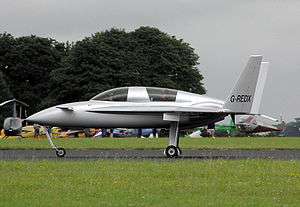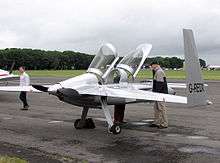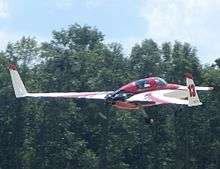Berkut 360
| Berkut 360 | |
|---|---|
 | |
| Role | Homebuilt aircraft |
| Manufacturer | Berkut Aircraft |
| Introduction | 1989 |
| Primary user | Private users |
| Number built | 31 [1] |
|
| |


The Berkut 360 is a tandem-seating two-seat homebuilt canard aircraft built primarily of carbon fiber and fiberglass.
The plane is featured in the 2010 movie Kill Speed (Fast Glass).[2][3]
Development
The prototype Berkut was designed and built by Dave H. Ronneberg as part of a business partnership between Ronneberg and Donald S. Murphy [4] (called Experimental Aviation) between 1989 and 1992.
In 1992 the partnership dissolved, and Ronneberg (incorporating as Experimental Aviation, Inc.) brought the aircraft to market as a kit, while Murphy wanted to shelve the project entirely. A subsequent series of lawsuits between the two resulted in bankruptcy for Ronneberg and Murphy as individuals, and for EAI as a corporation. The kit was resurrected by Renaissance Composites, in 1996, with Ronneberg working as a consultant.
In January 2001, under pressure from Ronneberg, Renaissance sold the assets to Vicki Cruse[5] who then formed Berkut Engineering Inc. That company withdrew the aircraft from the market in 2002. Ronneberg continues with the project, which is now directed at UAV markets.[6] In 2003 a deal was struck to sell the project to Republic Aerospace but the deal fell through. Cruse was no longer involved with day-to-day operations, but maintained ownership, until her death on August 22, 2009, when the plane she was flying (not a Berkut) crashed in Britain.
Through the various incarnations approximately 75 kits were sold, and 20 airplanes completed.
Configuration
The Berkut is descended from the Rutan Long-EZ, with the primary differences being retractable main landing gear, dual canopies, and molded fuselage, strakes, and spar. Like the Long EZ, the Berkut carries 2 people in tandem seats. The front seat occupant has access to all instrumentation and controls. The rear seat, normally holding the passenger, is equipped with a side stick and throttle, but no rudder pedals, brakes, or instruments. Aerodynamically, optimizations to the original Long-EZ airframe were made to increase performance and interior space. The fuselage was stretched, and the nose, canard, instrument panel and pilot moved forward one foot, to allow a heavier engine to be used in the back. The main wing trailing edge was straightened, removing a small bend in the trailing edge of the Long EZ wing. The lower winglet was removed and the aileron size increased in both chord and span, significantly increasing roll rate.
Early Berkuts used wings and canard that were structurally similar to the Long-EZ and used hot-wired solid blue 2 lb/cu. ft. density Dow STYROFOAM PI cores, but with carbon fiber skins instead of fiberglass. The fuselage and winglets remained fiberglass. Later versions (kits produced after spring 1999) used fully molded carbon fiber canards and wings with high density, 5 lb/cu. ft. 1/4" thick PVC or SAN foam cores, leaving only minor fairings and tip surfaces to be carved from foam. The Berkut has always used the Roncz 1145MS canard airfoil, which is more tolerant of bug and rain contamination than the original GU 25-5(11)8 airfoil originally used on the Long-EZ.
Berkuts used a retractable main (rear) landing gear system designed by Shirl Dickey for his E-Racer homebuilt. Originally Berkut used gear parts produced by Dickey, but over time they were repeatedly re-engineered and strengthened. Later kits had gear components produced entirely in-house. Like the earlier Vari-Eze and Long EZ, the Berkut parks with its nose gear retracted to prevent the plane from tipping over backwards when parked without a pilot in the front seat. Some early Berkuts utilized hydraulic nose-gear extension systems, but most have used an electro-mechanical jack-screw. With the electric system the pilot can climb into the cockpit with the nose down, then extend the nose gear, raising the airplane with him inside.
While the Long-EZ was closer in the design of the Berkut it was originally designed for the Lycoming O-235 108-118 hp engine, the Berkut was designed from the outset for the larger Lycoming IO-360 180 hp engine. The aircraft was later adapted (with a different engine mount, cowls and battery location) to accept the 260 hp Lycoming IO-540, which most builders chose. With the 540, some have reportedly reached speeds of 300 mph in level flight.
Selected accidents
The Berkut has a poor safety record, with about a quarter of all completed airplanes crashing at some point. However, there is no single cause which has resulted in more than one crash. Each crash has been the result of construction error or pilot error.
N91DR. The original prototype, crashed by Rick Fessenden at an airshow at Santa Paula, California. Although the NTSB investigation concluded that an accelerated stall during Fessenden's "wind up turn" - a level 360-degree very high-G turn - caused the airplane to crash, examination of videotapes of the crash gave a strong indication that the pilot blacked out under 9+ Gs. Fessenden was killed.[7]
N260DG. The first Berkut 540, built by Dan Gray, also crashed at Santa Paula. Gray started and finished his first flight at nearby Camarillo airport but on his second flight he chose to return to Santa Paula. On final approach his engine stopped and, in attempting to set down on a nearby freeway, he collided head-on with a Honda station wagon. The aircraft was extensively damaged but Gray was only bruised. The cause was found to be an incorrectly rebuilt fuel pump.[8]
N600SE. Built by Michael Kasyan, this airplane served as the company demonstrator for several years. While being flown by another pilot, the plane encountered a dust devil on final approach. This flipped the airplane upside down and it tumbled down the runway. Both wings were broken, the right strake and spar were broken halfway between the fuselage and the end of the spar, the main gear was torn out, and the nose crushed back to the instrument panel. The pilot's legs were broken but the passenger suffered only a minor cut to the scalp. The airplane was rebuilt and is flying again.[9]
N538AJ. This airplane, owned by John Daniels, has had several accidents, all involving the landing gear. The NTSB report concerns its first, a gear collapse at Jackson Hole, Wyoming. Later the airplane overran the runway at First Flight airport, tearing out its gear legs. There have been no injuries from any of the accidents.[10]
N827CM. Built by Steve Drybread. During a test flight Drybread left out the main canard attachment bolts. The canard separated in flight, and Drybread was killed.[11]
N5439N. Built by Steve Drybread. While being flown by its owner, Charles Bracken, the aircraft struck high tension power wires and crashed into the ground. The airplane was destroyed, the nose crushed back to the pilot's seat. Bracken's legs were broken.[12]
Variants
- Berkut 360
- Original configuration, retractable gear, Lycoming 4-cylinder 360-cubic-inch, fuel-injected, 180 hp engine.
- Berkut FG360
- Fixed-gear version of the 360. (Offered but never built, except as a UAV by Geneva Aerospace [6])
- Berkut 540
- Lycoming 6-cylinder, 540-cubic-inch, 260 hp engine upgrade. Changes consisted of larger cowls, a different engine mount, custom engine mount ears, stiffer engine isolators, a custom sump modification and different cooling baffles.
- Berkut FG540
- Fixed-gear version of the 540. (Offered but never built)
- Mobius
- a modified Berkut with a single canopy and automated flight equipment located where the second seat would be located, for UAV research and development with a 20hr endurance.[13] Two aircraft have been built with a third one in development. N442LT is the first tail number. N497LT is the second.[14][15]
- Berkut Jet
- a Berkut using a modified GE T-58 turbine engine, built by Jerrold Jorritsma.[16] Crashed in Loveland, CO on May 9, 2010[17]
- Berkez or Berk-EZ
- Heavily modified Rutan Long-EZ homebuilt with Berkut components.[18]
Specifications
Data from Brassey's World Aircraft & Systems Directory 1999/2000[19]
General characteristics
- Crew: 2
- Length: 18 ft 6 in (5.64 m)
- Wingspan: 26 ft 8 in (8.13 m)
- Height: 7 ft 6 in[20] (2.29 m)
- Empty weight: 1,035 lb (469 kg)
- Loaded weight: 2,000 lb (907 kg)
- Powerplant: 1 × Lycoming IO-360 air-cooled flat-four, 205 hp (153 kW)
Performance
- Maximum speed: 248 mph (215 knots, 399 km/h)
- Cruise speed: 220 mph (191 knots, 354 km/h)
- Stall speed: 70 mph (61 knots, 113 km/h)
- Range: 1,228 mi (1,066 nmi, 1,976 km)
- Service ceiling: 32,000 ft[20] (9,750 m)
- Rate of climb: 2,000 ft/min[20] (10.2 m/s)
See also
- Rutan Long-EZ
- Rutan VariEze
- Rutan Defiant
- Steve Wright Stagger-Ez
- Cozy MK IV
- Velocity SE
- Velocity XL
- Glassic SQ2000
References
- ↑ According to airport-data.com 31 Berkut got registered and got a tail number. This includes all variants.
- ↑ http://www.imdb.com/title/tt1027683/
- ↑ http://www.impdb.org/index.php?title=Kill_Speed
- ↑ Court transcript Archived March 15, 2007, at the Wayback Machine.
- ↑ EAA Chapter 96 newsletter, the Peninsula Flyer
- 1 2 UAV flight demonstration video
- ↑ NTSB report
- ↑ NTSB report
- ↑ NTSB report
- ↑ NTSB report
- ↑ NTSB report
- ↑ NTSB report
- ↑ "News Breaks". Aviation Week and Space Technology. 16 April 2007.
- ↑ FAA registration information for Mobius
- ↑ Air Combat Command story on Mobius Archived May 2, 2009, at the Wayback Machine.
- ↑ X-jets web page
- ↑
- ↑ Sport Aviation: 95. June 2013. Missing or empty
|title=(help) - ↑ Taylor 1999, p. 583.
- 1 2 3 Lambert 1993, p. 474.
- Lambert, Mark. Jane's All The World's Aircraft 1993–94. Coulsdon, UK: Jane's Data Division, 1993. ISBN 0-7106-1066-1.
- Taylor, Michael J. H. Brassey's World Aircraft & Systems Directory 1999/2000. London: Brassey's, 1999. ISBN 1-85753-245-7.
External links
| Wikimedia Commons has media related to Berkut 360. |
- James Redmon, who built Berkut serial number 013 (N97TX), maintains a website documenting his experience building and flying the plane. Mr Redmon has since been hired as a test pilot for Berkut Engineering.
- Flight test of the aircraft, and photographs
- Archived page of the manufacturer
- https://web.archive.org/web/20100704224828/http://www.l-3com.com:80/uas/tech_uas/mobius.htm